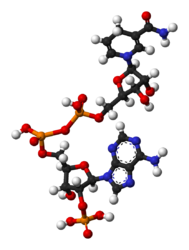Nicotinamide adenine dinucleotide phosphate
In plants
In photosynthetic organisms, NADPH is produced by ferredoxin-NADP+ reductase in the last step of the electron chain of the light reactions of photosynthesis. It is used as reducing power for the biosynthetic reactions in the Calvin cycle to assimilate carbon dioxide. It is used to help turn the carbon dioxide into glucose. It is also needed in the reduction of nitrate into ammonia for plant assimilation in nitrogen cycle.
In animals
The major source of NADPH in animals and other non-photosynthetic organisms is the pentose phosphate pathway.
However, there are several other lesser-known mechanisms of generating NADPH, all of which depend on the presence of mitochondria. The key enzymes in these processes are: NADP-linked malic enzyme, NADP-linked isocitrate dehydrogenase, NADP-linked glutamate dehydrogenase and nicotinamide nucleotide transhydrogenase.[1] The isocitrate dehydrogenase mechanism appears to be the major source of NADPH in fat and possibly also liver cells.[2] Also, in mitochondria, NADH kinase produces NADPH and ADP, using NADH and ATP as substrate.
Function
NADPH provides the reducing equivalents for biosynthetic reactions and the oxidation-reduction involved in protecting against the toxicity of ROS (reactive oxygen species), allowing the regeneration of GSH (reduced glutathione).[3] NADPH is also used for anabolic pathways, such as lipid synthesis, cholesterol synthesis, and fatty acid chain elongation.
The NADPH system is also responsible for generating free radicals in immune cells. These radicals are used to destroy pathogens in a process termed the respiratory burst.[4] It is the source of reducing equivalents for cytochrome P450 hydroxylation of aromatic compounds, steroids, alcohols, and drugs.
See also
References
- ^ Hanukoglu I, Rapoport R (Feb–May 1995). "Routes and regulation of NADPH production in steroidogenic mitochondria". Endocrine Research. 21 (1–2): 231–41. doi:10.3109/07435809509030439. PMID 7588385.
- ^ Palmer, Michael. "10.4.3 Supply of NADPH for fatty acid synthesis". Metabolism Course Notes. Retrieved 6 April 2012.
- ^ Rush, Glenn F.; Gorski, Joel R.; Ripple, Mary G.; Sowinski, Janice; Bugelski, Peter; Hewitt, William R. "Organic hydroperoxide-induced lipid peroxidation and cell death in isolated hepatocytes". Toxicology and Applied Pharmacology. 78 (3): 473–483. doi:10.1016/0041-008X(85)90255-8. PMID 4049396.
- ^ Ogawa K, Suzuki K, Okutsu M, Yamazaki K, Shinkai S (2008). "The association of elevated reactive oxygen species levels from neutrophils with low-grade inflammation in the elderly". Immunity & Ageing. 5: 13. doi:10.1186/1742-4933-5-13. PMC 2582223. PMID 18950479.
{{cite journal}}: CS1 maint: unflagged free DOI (link)


